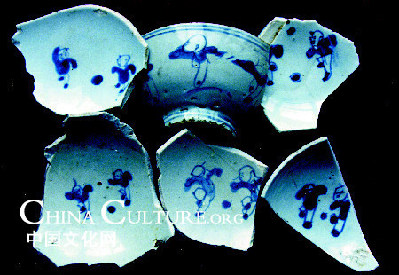In the Song Dynasty cuju organizations were set up in large cities called Qi Yun She or Yuan She-- now known as the earliest professional cuju club -- whose members were either cuju lovers or professional performers. Non-professional players had to formally appoint a professional as his or her teacher and pay a fee before becoming a member. This process ensured an income for the professionals.
Unlike cuju of the Tang Dynasty, only one goal post was set up in the middle of the field during the Song.
There are mainly two ways to play cuju: "Zhu Qiu" and "Bai Da" Zhu Qiu was commonly performed at court feasts celebrating the emperor's birthday or during diplomatic events. This competitive match between two teams consisted of 12-16 players on each side.
 Unearthed bowl with images of cuju playing
Unearthed bowl with images of cuju playing
Bai Da was the dominant cuju style of the Song Dynasty, attaching much importance to developing personal skills. The goal became obsolete in this method and the playing field was enclosed with thread, with players taking turns to kick the ball within. The number of fouls made by the players decided the winner. For example, if the ball was not passed far enough to reach the other players, points were deducted. If the ball was kicked too far out, a big deduction was made. Kicking the ball too low or turning at the wrong moment all led to fewer points. Players could touch the ball with any part of the body except their hands and the number of players ranged anywhere from two to 10. In the end, the player with the highest score would win.
Cuju began its decline during the Ming Dynasty (1368-1644) due to neglect, and the 2,000-year-old sport finally faded away.